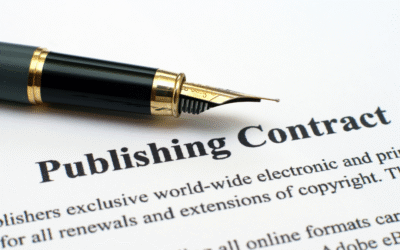Book publishing can seem like a daunting journey, but with the right strategies, you can navigate it successfully. In this guide, I will share critical insights and steps to take for getting your book published in 2024. From understanding the current publishing landscape to making smart choices about self-publishing or traditional publishing, I’ll help you avoid common pitfalls and arm you with the knowledge you need to achieve your goal. Let’s turn your manuscript into a published success!
Key Takeaways:
- Understand the Publishing Landscape: Familiarize yourself with the various publishing options available, including traditional, hybrid, and self-publishing, to determine the best fit for your book.
- Build Your Author Platform: Establish a strong online presence through social media and a personal website to engage with potential readers and industry professionals, increasing your chances of getting published.
- Focus on Quality Content: Ensure your manuscript is well-edited and polished, as high-quality writing is crucial for attracting publishers and readers alike.
Understanding the Publishing Landscape
The publishing landscape in 2024 is diverse and ever-evolving, making it crucial for authors to navigate it effectively. From traditional methods to modern self-publishing platforms, each path presents unique opportunities and challenges. To successfully publish your book, it’s crucial to familiarize yourself with the various avenues available for bringing your work to market.
The Different Types of Publishing
The publishing industry offers several options for authors, each catering to different goals and audiences:
- Traditional Publishing
- Self-Publishing
- Hybrid Publishing
- Print-on-Demand
- Digital Publishing
Recognizing the differences between these types can empower you to choose the best route for your publishing journey.
| Type | Overview |
| Traditional Publishing | Involves large publishing houses; they handle editing, distribution, and marketing. |
| Self-Publishing | Authors publish their own work, retaining full control of the process. |
| Hybrid Publishing | Combines aspects of traditional and self-publishing; often requires upfront investment. |
| Print-on-Demand | Books are printed as orders are received, minimizing upfront costs. |
| Digital Publishing | Focus on eBooks and online distribution; lower costs and quick accessibility. |
Choosing Between Traditional and Self-Publishing
You must weigh the pros and cons of traditional and self-publishing to determine the best fit for your book. Traditional publishing offers the backing of an established publisher but often involves a lengthy process and less creative control. In contrast, self-publishing gives you independence and faster market access, yet comes with the responsibility of managing every aspect of the publishing process.
A decision between traditional and self-publishing requires careful consideration of your goals, audience, and willingness to handle publishing tasks. While traditional publishing can provide valuable expertise and wider reach, it may also include stringent gatekeeping and a lengthy timeline. Conversely, self-publishing offers immediate access to your readers and greater control but includes the risks of higher upfront costs and potential challenges in marketing. Ultimately, I encourage you to assess your own strengths and aspirations before making this vital decision.
Crafting Your Manuscript
You have a story to tell, and the first step to sharing it with the world is crafting your manuscript. Focus on developing a strong narrative arc, creating vivid characters, and honing your unique voice. Remember that your first draft is just the beginning; embrace the revision process to refine your ideas and polish your prose.
Tips for Writing and Editing
To elevate your writing, consider these tips for effective editing:
- Set clear goals for each writing session.
- Read your work aloud to catch errors.
- Seek feedback from trusted peers.
- Take breaks to gain fresh perspectives.
Perceiving your own work objectively can be challenging, but it is vital for growth as a writer.
Preparing Your Manuscript for Submission
Any manuscript intended for submission requires careful preparation to increase its chances of success. I suggest formatting your work according to industry standards, ensuring that it adheres to each publisher’s specific requirements. Additionally, take the time to write a compelling query letter that succinctly summarizes your book while capturing its unique essence.
It’s crucial to remember that a well-prepared manuscript can make a significant impression on agents or publishers. Be sure to double-check your formatting, as an inconsistent layout can be distracting. Furthermore, pay attention to grammar and punctuation, as any oversights could diminish the professionalism of your submission. Take the time to polish your manuscript and craft a strong synopsis; this can be a game-changer. Ultimately, a meticulously prepared manuscript reflects your commitment to your story and can set you apart in a competitive market.
Factors to Consider Before Publishing
Now, before you leap into the world of publishing, it’s crucial to evaluate several factors that will contribute to your book’s success. Consider the following:
- Publishing options
- Budget
- Marketing strategies
- Editing and formatting
Thou must weigh these aspects carefully to ensure a smooth transition from manuscript to published work.
Genre and Target Audience
With a clear understanding of your book’s genre and target audience, you can tailor your content to meet your readers’ expectations. Identifying specific demographics will help you in your marketing efforts, ensuring that your book reaches those most likely to enjoy it.
Market Trends in 2024
Audience preferences are continually shifting, and it’s crucial to stay updated on market trends. In 2024, readers are gravitating towards authentic voices and diverse narratives, with an increasing emphasis on sustainability in publishing. Additionally, digital formats continue to rise, pushing traditional print options to adapt.
Market trends indicate an evolving landscape that writers must navigate carefully. As hybrid publishing gains popularity, the lines between self-publishing and traditional publishing blur. It’s vital to remain informed about reader preferences and the technologies shaping the future of books. Prioritize authenticity and explore niche markets to connect with your audience meaningfully. Understanding these shifts will empower you to make informed decisions for your publishing journey.
Navigating the Submission Process
All aspiring authors must familiarize themselves with the submission process to enhance their chances of getting published. This step can be daunting, but with the right knowledge, you can approach it confidently. Start by researching literary agents and publishers who are suitable for your genre, and ensure you understand their specific submission guidelines. Tailoring your submissions to meet their criteria will show professionalism and increase your likelihood of success.
How to Write a Query Letter
Assuming you have completed your manuscript, the next step is writing a compelling query letter. A well-crafted query letter should grab the agent’s attention right away, summarizing your book’s plot, character arcs, and its unique selling points. Make sure to personalize each letter and convey your passion for your work, as this will create a stronger connection with the agent.
Formatting Your Manuscript
Submission guidelines often emphasize the importance of formatting your manuscript correctly, as it reflects your professionalism and attention to detail.
Another critical aspect is understanding the standard manuscript format. I recommend using a 12-point Times New Roman font, double-spacing your text, and employing 1-inch margins on all sides. Additionally, make sure to include page numbers and your last name in the header, as well as a title page that features your book’s title and your contact information. Following these guidelines ensures that your manuscript not only looks polished but also adheres to industry standards, thus making a positive impression on agents and editors alike.
Building Your Author Brand
Not only is your book important, but so is your identity as an author. Building a strong author brand will help you connect with readers and stand out in a crowded market. Your brand should reflect your personality, writing style, and the themes present in your work. Craft a consistent message across all platforms, from your social media profiles to your website, to create a cohesive image that draws readers in and keeps them engaged.
Establishing Your Online Presence
The digital landscape is imperative for any aspiring author. I encourage you to establish a user-friendly, informative website that showcases your work and includes a blog, newsletter, or other engaging content. Utilize social media platforms like Instagram, Twitter, and Facebook to share updates, insights, and to connect with other writers and readers. Engaging consistently online will help you develop a following and get your work recognized.
Engaging with Readers and Influencers
Online engagement is crucial in amplifying your author brand. I find that connecting with readers and influencers creates a supportive community around my writing. By responding to comments, participating in discussions, and sharing valuable content, I can build relationships that inspire loyalty and advocacy. Furthermore, collaborating with influencers can >expose< your work to a broader audience, driving interest and generating positive buzz. Always remember to approach these interactions with authenticity; shared experiences and genuine conversations cultivate stronger connections.
Building your author brand necessitates proactive engagement with readers and influencers alike. The most effective way to achieve this is by highlighting your work through thoughtful interactions and showing appreciation for your audience’s support. Participating in reader discussions on platforms like Goodreads expands your reach, while collaborating with influencers not only elevates your profile but also fosters credibility in your niche. Don’t hesitate to share your writing journey and ask for feedback; authenticity is key. I cannot stress enough how these relationships can catapult your presence in the literary world, ultimately leading to greater opportunities.
Marketing Your Book
Your book’s journey doesn’t end with publication; effective marketing is crucial for success. I encourage you to develop a comprehensive marketing strategy that includes building an author platform, engaging with readers, and utilizing various promotional avenues. By doing so, you can significantly increase your book’s visibility and reach potential readers eager to discover your work.
Strategies for Effective Book Promotion
Even if you have an amazing book, without strategic promotion, it may go unnoticed. I recommend utilizing email newsletters, participating in online book tours, and collaborating with influencers in your genre. Bear in mind, consistent engagement with your audience can turn casual readers into loyal fans.
Leveraging Social Media and Reviews
Media plays a vital role in today’s book marketing landscape. By harnessing platforms like Instagram, Twitter, and Facebook, you can share updates, host giveaways, and interact with your audience. Additionally, encouraging readers to leave honest reviews on platforms like Amazon and Goodreads can amplify your book’s credibility and attract new readers.
Effective social media promotion can elevate your book’s visibility while *reviews* act as digital testimonials that build trust. I recommend curating engaging posts that resonate with your audience and encourage them to share their thoughts. Moreover, remember to respond to comments and messages to foster a sense of community. Negative feedback, though tough to handle, can provide valuable insights for future projects, while positive reviews strengthen your reputation. Prioritize relationships with your readers, and utilize their feedback to enhance your marketing strategy.
Summing up
As a reminder, mastering the art of publishing in 2024 requires you to stay informed, utilize the right resources, and maintain a focus on your unique voice and audience. I encourage you to take the time to explore various publishing avenues, whether traditional or self-publishing, and understand the nuances of each. By cultivating a strategic approach and leveraging the tools available, you can successfully navigate the publishing landscape and see your book in the hands of eager readers. Now is the time to take action and bring your literary vision to life!
FAQ
Q: What are the first steps I should take to get my book published in 2024?
A: The first steps to publishing your book in 2024 involve thorough preparation and research. Start by completing your manuscript and editing it meticulously to ensure high quality. Next, research the various publishing options available, such as traditional publishing, self-publishing, or hybrid models. Create a compelling query letter and a synopsis of your work if you’re considering traditional publishing. Attend local writing workshops and connect with other authors to build your network. Finally, update your knowledge about the latest industry trends and publishing platforms that have emerged in 2024.
Q: What is the difference between traditional publishing and self-publishing?
A: Traditional publishing involves submitting your manuscript to a publishing house, which handles the editing, design, marketing, and distribution of your book. In this scenario, you typically do not pay any upfront costs, but you share a portion of the royalties with the publisher. Self-publishing, on the other hand, allows you to maintain complete creative control over your work, but you are also responsible for all aspects of production, including editing, design, and marketing. In 2024, many authors are opting for self-publishing due to the ease of access to platforms like Amazon Kindle Direct Publishing and the potential for higher profits.
Q: What marketing strategies should I consider for my book in 2024?
A: In 2024, effective marketing strategies for your book include building an author brand through social media platforms like Instagram, TikTok, and Facebook, where you can engage your audience and share sneak peeks of your work. Consider creating a professional website and an email newsletter to connect with your readers directly. Collaborate with book bloggers and influencers to promote your book through reviews and giveaways. Additionally, utilizing paid advertising on social media and platforms like Amazon can help boost visibility. Lastly, participating in virtual book tours and literary events can expand your reach and connect you with potential readers.








